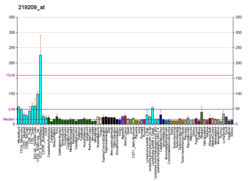MDA5 (melanoma differentiation-associated protein 5) is a RIG-I-like receptor dsRNA helicase enzyme that is encoded by the IFIH1 gene in humans.[5] MDA5 is part of the RIG-I-like receptor (RLR) family, which also includes RIG-I and LGP2, and functions as a pattern recognition receptor capable of detecting viruses. It is generally believed that MDA5 recognizes double stranded RNA (dsRNA) over 2000nts in length,[6] however it has been shown that whilst MDA5 can detect and bind to cytoplasmic dsRNA, it is also activated by a high molecular weight RNA complex composed of ssRNA and dsRNA.[7] For many viruses, effective MDA5-mediated antiviral responses are dependent on functionally active LGP2.[8] The signaling cascades in MDA5 is initiated via CARD domain.[9] Some observations made in cancer cells show that MDA5 also interacts with cellular RNA is able to induce an autoinflammatory response.[10]
- ^ a b c GRCh38: Ensembl release 89: ENSG00000115267 – Ensembl, May 2017
- ^ a b c GRCm38: Ensembl release 89: ENSMUSG00000026896 – Ensembl, May 2017
- ^ "Human PubMed Reference:". National Center for Biotechnology Information, U.S. National Library of Medicine.
- ^ "Mouse PubMed Reference:". National Center for Biotechnology Information, U.S. National Library of Medicine.
- ^ "Entrez Gene: IFIH1 interferon induced with helicase C domain 1".
- ^ Kato H, Takeuchi O, Mikamo-Satoh E, Hirai R, Kawai T, Matsushita K, et al. (July 2008). "Length-dependent recognition of double-stranded ribonucleic acids by retinoic acid-inducible gene-I and melanoma differentiation-associated gene 5". The Journal of Experimental Medicine. 205 (7): 1601–10. doi:10.1084/jem.20080091. PMC 2442638. PMID 18591409.
- ^ Pichlmair A, Schulz O, Tan CP, Rehwinkel J, Kato H, Takeuchi O, et al. (October 2009). "Activation of MDA5 requires higher-order RNA structures generated during virus infection". Journal of Virology. 83 (20): 10761–9. doi:10.1128/JVI.00770-09. PMC 2753146. PMID 19656871.
- ^ Satoh T, Kato H, Kumagai Y, Yoneyama M, Sato S, Matsushita K, et al. (January 2010). "LGP2 is a positive regulator of RIG-I- and MDA5-mediated antiviral responses". Proceedings of the National Academy of Sciences of the United States of America. 107 (4): 1512–7. Bibcode:2010PNAS..107.1512S. doi:10.1073/pnas.0912986107. PMC 2824407. PMID 20080593.
- ^ Takeuchi O, Akira S (February 2008). "MDA5/RIG-I and virus recognition". Current Opinion in Immunology. 20 (1): 17–22. doi:10.1016/j.coi.2008.01.002. PMID 18272355.
- ^ Dias Junior AG, Sampaio NG, Rehwinkel J (January 2019). "A Balancing Act: MDA5 in Antiviral Immunity and Autoinflammation". Trends in Microbiology. 27 (1): 75–85. doi:10.1016/j.tim.2018.08.007. PMC 6319154. PMID 30201512.





